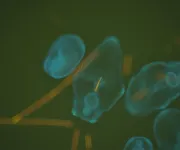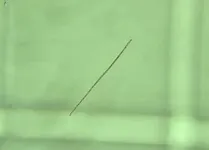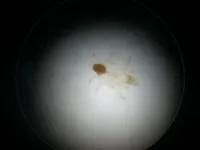(Press-News.org) Researchers have uncovered an under-the-sea phenomenon where coral-destroying crown-of-thorns starfish larvae have been feasting on blue-green algae bacteria known as ‘sea sawdust’.
The team of marine scientists from The University of Queensland and Southern Cross University found crown-of-thorns starfish (COTS) larvae grow and thrive when raised on an exclusive diet of Trichodesmium – a bacteria that often floats on the ocean’s surface in large slicks.
UQ’s Dr Benjamin Mos from the School of Environment said scientists had thought almost nothing touched this threadlike bacteria because of its toxicity and poor nutritional content.
“Until now, not much has been known about sea sawdust as a food source, so we were certainly surprised to say the least,” Dr Mos said.
“Blue-green algae blooms can extend hundreds to thousands of kilometres across the ocean and often float on the surface in large rafts like sawdust – hence the name.
“It plays a crucial role in marine ecosystems by making nitrogen from the atmosphere available to other sea life, but now we know it is also a food source.
“By knowing how sea sawdust helps COTS thrive, we can potentially change the way we combat this very damaging coral predator.”
By tracing atoms from bacteria to COTS larvae, researchers found the larvae digested nitrogen from sea sawdust, with the nitrogen moving into their tissues for sustenance.
“With sea sawdust blooms on the rise in recent years, our findings suggest this could help explain the increase in COTS populations, which have devastated our coral reefs for decades,” Dr Mos said.
These findings build on earlier research that suggests human activities, such as fertiliser use, sewage treatment, and stormwater runoff, may be responsible for the increase in blue-green algae blooms.
“It’s important we understand the flow-on effect of how human impacts in one ecosystem might flow on to other seemingly unrelated ecosystems,” Dr Mos said.
Professor Symon Dworjanyn from Southern Cross University’s National Marine Science Centre said further work was needed to investigate the potential connection between sea sawdust blooms and the number of coral-eating COTS.
“If we can figure out how to reduce the impact of COTS, we might give coral reefs a little more time,” Professor Dworjanyn said.
“We don’t yet know if sea sawdust blooms result in more adult COTS on coral reefs, so this research needs more work.
“However, our findings could be an important part of cracking that puzzle.”
This research is published in Science Advances.
END
Reef pest feasts on 'sea sawdust'
2024-07-17
ELSE PRESS RELEASES FROM THIS DATE:
Mental health training for line managers linked to better business performance, says new study
2024-07-17
Mental health training for line managers is strongly linked to better business performance, and it could save companies millions of pounds in lost sick days every year, according to new research led by experts at the University of Nottingham.
The results of the study, which are published in PLOS ONE, showed a strong association between mental health training for line managers and improved staff recruitment and retention, better customer service, and lower levels of long-term mental health sickness absence.
The study was led by Professor Holly Blake from the School of Health Sciences at the University of Nottingham and Dr Juliet Hassard of Queen’s ...
Diatom surprise could rewrite the global carbon cycle
2024-07-17
When it comes to diatoms that live in the ocean, new research suggests that photosynthesis is not the only strategy for accumulating carbon. Instead, these single-celled plankton are also building biomass by feeding directly on organic carbon in wide swaths of the ocean. These new findings could lead researchers to reduce their estimate of how much carbon dioxide diatoms pull out of the air via photosynthesis, which in turn, could alter our understanding of the global carbon cycle, which is especially relevant given the changing climate.
This research is led by bioengineers, bioinformatics experts and other genomics researchers ...
Microbes found to destroy certain ‘forever chemicals’
2024-07-17
UC Riverside environmental engineering team has discovered specific bacterial species that can destroy certain kinds of “forever chemicals,” a step further toward low-cost treatments of contaminated drinking water sources.
The microorganisms belong to the genus Acetobacterium and they are commonly found in wastewater environments throughout the world.
Forever chemicals, also known as per- and polyfluoroalkyl substances or PFAS, are so named because they have stubbornly strong carbon-fluorine chemical bonds, which make them persistent in the environment.
The microorganisms discovered by UCR scientists and their collaborators ...
When the brain speaks, the heart feels it
2024-07-17
Research by the Technion has demonstrated that activation of the brain’s reward system could boost recovery from a heart attack. The research, which was conducted at the Ruth and Bruce Rappaport Faculty of Medicine, was led by Ph.D. student Hedva Haykin under the supervision of Prof. Asya Rolls and Prof. Lior Gepstein.
The Technion research group focused on the reward system, a brain network activated in positive emotional states and motivation and evaluated its potential in improving recovery ...
Llama nanobodies: A breakthrough in building HIV immunity
2024-07-17
ATLANTA — A research team at Georgia State University has developed tiny, potent molecules that are capable of targeting hidden strains of HIV. The source? Antibody genes from llama DNA.
The research, led by Assistant Professor of Biology Jianliang Xu, uses llama-derived nanobodies to broadly neutralize numerous strains of HIV-1, the most common form of the virus. A new study from this team has been published in the journal Advanced Science.
“This virus has evolved a way to escape our immune system. Conventional antibodies are bulky, so it’s difficult for them to find and attack the virus’ surface,” ...
How our brains learn new athletic skills fast
2024-07-17
You join a swing dance class, and at first you’re all left feet. But – slowly, eyes glued to the teacher – you pick up a step or two and start to feel the rhythm of the big band beat. A good start.
Then you look over and realize the couple next to you has picked up twice the steps in half the time.
Why?
According to a new study from University of Florida biomechanical researchers, the quick, athletic learners among us really are built differently – inside their brains.
That’s what UF Professor of Biomedical Engineering Daniel Ferris, Ph.D., and his former doctoral student, Noelle Jacobsen, Ph.D., discovered when they studied how people learn ...
New Durham University study shows promising diagnosis of Multiple Sclerosis from images of the eye
2024-07-17
-With images-
Researchers at Durham University, UK and Isfahan University of Medical Sciences, Iran have developed an innovative approach to diagnosing Multiple Sclerosis using advanced eye imaging techniques.
This groundbreaking method could revolutionise how Multiple Sclerosis is detected, offering a faster, less invasive, and more accessible alternative to current diagnostic procedures.
The study, led by Dr Raheleh Kafieh of Durham University, integrates two types of eye scans: optical coherence tomography (OCT) and infrared scanning laser ophthalmoscopy (IR-SLO).
By training computer models ...
New training program facilitates home-based transcranial electrical stimulation
2024-07-17
Traveling to and from a clinic or a laboratory for treatment can be difficult and expensive for older Americans. To address this, scientists developed and tested a new training and supervision program for older adults so they can receive Transcranial Electrical Stimulation (tES), a promising intervention for various clinical conditions, in their homes.
Published in Neuromodulation: Technology at the Neural Interface, this groundbreaking training and supervision program was designed to introduce and teach caregivers, family members, and patients how to administer home-based transcranial electrical stimulation (HB-tES), equipping them ...
Study finds persistent proteins may influence metabolomics results
2024-07-17
GRAND RAPIDS, Mich. (July 17, 2024) — Van Andel Institute scientists have identified more than 1,000 previously undetected proteins in common metabolite samples, which persist despite extraction methods designed to weed them out.
The findings, published in Nature Communications, give scientists new insights and tools for improving future metabolomics experiments, including a novel protocol for removing these proteins during the extraction process. The study does not invalidate prior results but instead reinforces the importance ...
Living in greener neighborhoods during midlife can slow cognitive decline
2024-07-17
A new study found that increased exposure to residential greenery may help stave off cognitive decline by an annual rate of eight months. This delay was observed more among people living in low-socioeconomic status and highly populated neighborhoods, as well as people who carry the APOE-ɛ4 gene, which is associated with an increased risk of Alzheimer’s disease.
Research has shown that about 40 percent of dementia could be prevented or delayed worldwide by addressing modifiable risk factors associated with the condition, particularly during midlife.
A new study led by a Boston University School of Public Health (BUSPH) ...



